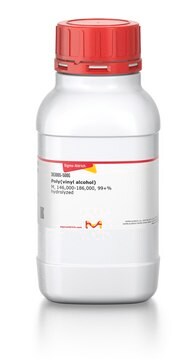11019
Aluminum chloride
anhydrous, sublimed, ≥98%
About This Item
Productos recomendados
vapor pressure
1 mmHg ( 100 °C)
assay
≥98%
form
powder
quality
anhydrous
sublimed
reaction suitability
reagent type: catalyst
core: aluminum
impurities
≤0.005% heavy metals (as Pb)
pH
2.4 (20 °C, 100 g/L)
mp
190 °C (lit.)
anion traces
sulfate (SO42-): ≤500 mg/kg
cation traces
Fe: ≤200 mg/kg
SMILES string
Cl[Al](Cl)Cl
InChI
1S/Al.3ClH/h;3*1H/q+3;;;/p-3
InChI key
VSCWAEJMTAWNJL-UHFFFAOYSA-K
¿Está buscando productos similares? Visita Guía de comparación de productos
Categorías relacionadas
Application
- The coagulation process for virus removal in turbid water: Explores the use of aluminum chloride in the coagulation process to remove both enveloped and non-enveloped viruses, including SARS-CoV-2 Omicron BA.2, from turbid water. This research is crucial for environmental lab technicians and researchers in academia focusing on water treatment and public health safety (Maneein S et al., 2024).
- Enhancing pollutants removal in hospital wastewater: Compares PAC coagulation and bio-contact oxidation methods in wastewater treatment, underscoring the impact of outdated plants and the role of aluminum chloride in enhancing pollutant removal efficiency. This study is essential for environmental scientists and engineers tasked with upgrading and optimizing wastewater treatment processes (Kang Y et al., 2024).
- Comparing the effects of Al-based coagulants in waste activated sludge anaerobic digestion: Analyzes methane yield, kinetics, and sludge implications when using aluminum-based coagulants, providing valuable insights for environmental engineers and material scientists interested in resource recovery and sustainable waste management (Pasciucco F et al., 2024).
Features and Benefits
Caution
signalword
Danger
hcodes
Hazard Classifications
Eye Dam. 1 - Skin Corr. 1B
supp_hazards
Storage Class
8B - Non-combustible corrosive hazardous materials
wgk_germany
WGK 1
flash_point_f
Not applicable
flash_point_c
Not applicable
Certificados de análisis (COA)
Busque Certificados de análisis (COA) introduciendo el número de lote del producto. Los números de lote se encuentran en la etiqueta del producto después de las palabras «Lot» o «Batch»
¿Ya tiene este producto?
Encuentre la documentación para los productos que ha comprado recientemente en la Biblioteca de documentos.
Los clientes también vieron
Nuestro equipo de científicos tiene experiencia en todas las áreas de investigación: Ciencias de la vida, Ciencia de los materiales, Síntesis química, Cromatografía, Analítica y muchas otras.
Póngase en contacto con el Servicio técnico









